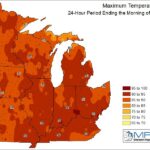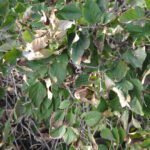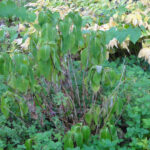 Purdue University - Extension - Forestry and Natural Resources
Purdue University - Extension - Forestry and Natural Resources
Got Nature? Blog
Purdue Landscape Report: Many areas around the Midwest continue to creep towards an increasing drought situation. Currently almost 80% of the Midwest is listed as being abnormally dry to exceptional drought. Current soil moisture data indicates that most of the Midwest is very dry. Going into the fall it’s very important to supply enough supplemental water (irrigation) to make up for the deficit prior to the landscape plants going dormant over the next six to eight weeks.
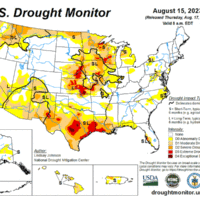
Figure 1. The progression of drought conditions have increased over the last two months in the Midwest. U.S. Drought Monitor.
The fall is a very important time to limit stressors on landscape plants. A stressed plant doesn’t produce as many secondary metabolites which aide in increased cold hardiness; so keeping your landscape plants irrigated during dry periods in late summer into fall is an important component of preparing plants for winter.
Remember some key steps concerning your landscape during extreme dry periods:
- Don’t wait until leaves begin dropping to start watering.
- Trees should receive the 5+5 rule.
- 5 gallons, plus 5 gallons per caliper inch.
- Ideally watering should occur in the early morning to prevent foliar diseases.
- Mulching to 3” can conserve moisture and reduce temperature in the upper root zone.
- Watering during dry conditions will help prevent future insect, disease, and other stress issues going into the fall and the following year. In fact, plants going into the winter that are stressed due to water deficiency will reduce the cold hardiness and therefore will be more likely to suffer cold injury and/or death.
- If a plant isn’t receiving enough water, the amount of nutrient uptake will not be sufficient and will experience deficiency from nutrients the following year.
To view this full article and other Purdue Landscape Report articles, please visit Purdue Landscape Report.
Subscribe and receive the newsletter: Purdue Landscape Report Newsletter.
Resources:
Trees in Times of Drought, Video, Purdue Agriculture
Drought Information, Indiana Department of Natural Resources
Drought? Don’t forget the trees!, The Education Store
Corn Belt Farmers’ Concerns About Drought and Heat-related Threats to Their Farm Operations, The Education Store
Safety Harvesting Quality Forage in a Drought, The Education Store
Planting Your Tree Part 1: Choosing Your Tree, Purdue Extension YouTube Channel
Tree Defect Identification, The Education Store
Tree Wound and Healing, Got Nature? Blog, Purdue Extension – Forestry and Natural Resources
Surface Root Syndrome, The Education Store
Planning the Tree Planting Operation, The Education Store
Tree Risk Management, The Education Store
ID That Tree, Purdue Extension-FNR YouTube playlist
Subscribe – Purdue Extension-FNR YouTube Channel
Kyle Daniel, Commercial Landscape and Nursery Crops Extension Specialist
Purdue Horticulture & Landscape Architecture
Purdue Landscape Report: Many trees are planted for their beautiful fall color, especially in locations where the climate provides reliable autumn weather. I have said this multiple times during extension talks and conversations with submitters to the Purdue Pest & Plant Diagnostic Lab (PPDL), but I seem to have not experienced a ‘normal’ fall since moving to Indiana with how erratic the weather has been from year to year. Depending on weather conditions, such as high heat and drought, colors may develop early or may be duller for specific varieties than expected.
However, individual trees that begin to show fall colors earlier than expected (August, September, even early October) may be shouting out a proverbial cry for help. Plants will often show yellow or red foliage coloration during periods of stress, so this may occur at any point during spring, summer, or fall. Individual trees may also show fall coloration earlier than others of their species in the same area. Now is the time to keep an eye out for this kind of early fall color as it can give you a heads-up on issues you can expect next year.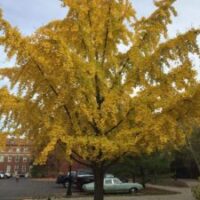
When examining a tree with early fall color, I would recommend checking the following:
- Is there a root flare?
Purdue Landscape Report: Deep Planting article- If not – tree could be planted too deep or the soil grade may have been changed
- Is there any obvious damage to the trunk, root flare, or surface roots?
- If so, there could internal decay that is not obvious and could be contributing to stress
- Are there any girdling roots?
Purdue Landscape Report: Stem Girdling Roots article- If present, they could be affecting the vascular system and strangling the tree
- Is the rootzone mulched?
- If not, the tree could be under stress from earlier drought, or weed and grass competition.
- If so, make sure it is not mounded against the trunk of the tree
- Does the soil appear compacted? Was there construction near the tree within the last 5 years?
- Compaction leads to issues with water, nutrient, and even oxygen availability to the roots and could lead to general decline
It is important to know the host species, but with the sheer volume of plant material available for sale in the nursery trade, it is even more important to know the cultivar that you are planting so you know what you might expect coming into the fall.
To view this full article and other Purdue Landscape Report articles, please visit Purdue Landscape Report.
Subscribe and receive the newsletter: Purdue Landscape Report Newsletter.
Resources:
Why Fall Color is Sometimes a Dud, Purdue Landscape Report
Forest Migration Plays a Role in Fall Foliage Colors, Purdue College of Agriculture News
U.S. Forest Service Fall Colors, Forest Service, U.S. Department of Agriculture
ID That Tree Fall Color: Sugar Maple, Purdue Extension – Forestry and Natural Resources YouTube Channel, ID That Tree Playlist
ID That Tree Fall Color Edition: Black Gum, Purdue Extension – FNR YouTube Channel, ID That Tree Playlist
Autumn Highlights Tour – South Campus, Purdue Arboretum Explorer
Why Leaves Change Color – the Physiological Basis, The Education Store, Purdue Extension resource center
Subscribe, Purdue Extension-Forestry and Natural Resources YouTube Channel
Planting Your Tree Part 1: Choosing Your Tree, Purdue Extension YouTube Channel
Summer Tree Care, Purdue Landscape Report
Tree Defect Identification, The Education Store
Tree Wound and Healing, Got Nature? Blog, Purdue Extension – Forestry and Natural Resources
Surface Root Syndrome, The Education Store
Shrubs and Woody Vines of Indiana and the Midwest, The Education Store
Ask an Expert: Tree Selection and Planting, Purdue Extension-Forestry & Natural Resources (FNR) YouTube playlist
ID That Tree, Purdue Extension-FNR YouTube playlist
John Bonkowski, Plant Disease Diagnostician
Departments of Botany & Plant Pathology
Much like the winter season, which has produced warm and relatively wet conditions across most of the state, the Climate Prediction Center is calling for continued above average temperatures and precipitation for Indiana this spring.
 The March, April and May weather outlook is influenced again by the continuing La Nina conditions in the El Nino Southern Oscillation (ENSO). Unlike previous seasons, models are showing growing certainty that La Nina conditions will give way to ENSO-neutral conditions during the end of springtime. This would conclude La Nina’s current event lasting over two years.
The March, April and May weather outlook is influenced again by the continuing La Nina conditions in the El Nino Southern Oscillation (ENSO). Unlike previous seasons, models are showing growing certainty that La Nina conditions will give way to ENSO-neutral conditions during the end of springtime. This would conclude La Nina’s current event lasting over two years.
The majority of the wetter than average predictions are likely to occur early in March and potentially through April. The end of La Nina would remove certainty of increased wet or dry conditions in May. Potential precipitation anomalies are predicted to be at least one inch greater than average precipitation across the state, with higher amounts in the south.
Temperature is also affected by the removal of La Nina, with the current warming signal weakening toward the end of spring. During early springtime, the glut of the warmth over the southeastern U.S. will spread northward into Indiana. Temperatures are too close to call for warmth or coolness in northwest Indiana, a line north of Terre Haute to South Bend. Predicted temperature anomalies are very low across the state, with a warming anomaly of 0.2 degrees Fahrenheit in the southern part of the state and 0.05 degrees Fahrenheit in the north.
Any areas of the state currently in abnormally dry conditions in the U.S. Drought Monitor are likely to be removed in the near future as these predictions play out. The Climate Prediction Center does not expect drought development anywhere in Indiana over the next three months.
For those with intentions of planting outdoors, lack of drought is good. However, planting windows may be shorter in the early spring period.
Resources:
Climate Change and Sustainable Development, The Education Store, Purdue Extension’s resource center
Climate Change: Are you preparing for it?, The Education Store
Conservation through Community Leadership, The Education Store
Indiana Prepared (IN PREPared), Purdue Extension
Trees Stressed Due to Drought? Know the Signs and What to Do, Purdue Extension – Forestry and Natural Resources (FNR) Got Nature? Blog
Drought? Don’t forget the trees!, The Education Store
Hans Schmitz, Climate Smart Agriculture and Soil Health Coordinator
Purdue Extension – Agriculture & Natural Resources
Purdue Landscape Report, What is Happening to the Weeping Willows?: While recent temperatures have been moderate in many parts of the state, rainfall has been lacking. (See The Annual Drought Article). There are chasms in the clay of my backyard that will swallow my kids and dogs whole. While I am not truly worried about the safety of my smaller family members, a lot of the plants that are not in shade are stressed. At the Purdue Plant and Pest Diagnostic Laboratory, we have received quite a few calls, emails, and samples about trees in decline. Trees that are already stressed, infected by a pathogen, or are infested by wood-boring insects will be showing their true colors in these drought conditions: chlorosis, leaf loss, and limb dieback.
Willow showing yellowing of older leaves on lower branches.
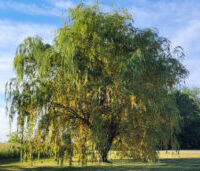 This month, one group of trees limps along to the top of our list of plants under stress due to lack of water: Willows. Salix spp. are not great landscape trees in general unless planted in locations that retain water. While they grow quickly and can appear beautiful for a number of years, when the soil becomes dry, these trees can very quickly develop limb dieback or cankers. In many cases, cankers become more obvious during these periods of stress because they were already present before the drought stress occurs. Damaged limbs die faster and multiple species of canker-causing fungi have been found to move faster in drought stressed wood of some tree species. We have found the fungi Cytospora, Botryosphaeria, and Colletotrichum associated with cankers on recent branch submissions to the lab.
This month, one group of trees limps along to the top of our list of plants under stress due to lack of water: Willows. Salix spp. are not great landscape trees in general unless planted in locations that retain water. While they grow quickly and can appear beautiful for a number of years, when the soil becomes dry, these trees can very quickly develop limb dieback or cankers. In many cases, cankers become more obvious during these periods of stress because they were already present before the drought stress occurs. Damaged limbs die faster and multiple species of canker-causing fungi have been found to move faster in drought stressed wood of some tree species. We have found the fungi Cytospora, Botryosphaeria, and Colletotrichum associated with cankers on recent branch submissions to the lab.
Thinning of the branches, cracks/splits in the bark, and black lesions on green stems can indicate the presence of a canker which should be pruned out and destroyed, if at all possible. Supplemental irrigation may be required during dry spells for trees that are water loving or, at least, drought intolerant. Fungicides are not effective for these fungal pathogens that live inside the wood, where fungicides can’t penetrate. In most cases larger willow trees will not die because of these problems but they may suffer significant branch loss and may become disfigured. In some cases very young trees or shrub type willows may be killed.
For full article and photos view: What is Happening to the Weeping Willows?
Resources:
Summer Tree Care, Purdue Landscape Report
Drought? Don’t Forget the Trees!, The Education Store, Purdue Extension resource center
Extreme Heat, Purdue Extension – IN-PREPared
Drought Information, Indiana Department of Natural Resources
Planting Your Tree Part 1: Choosing Your Tree, Purdue Extension YouTube Channel
Tree Selection for the “Un-natural” Environment, The Education Store
Tree Pruning Essentials Video, Purdue Extension YouTube Channel
Tree Defect Identification, The Education Store
Tree Wound and Healing, Got Nature? Blog, Purdue Extension – Forestry and Natural Resources
Surface Root Syndrome, The Education Store
John Bonkowski, Plant Disease Diagnostician
Plant and Pest Diagnostic Laboratory
 The Nature of Teaching, a Purdue Extension signature program, was honored as the third place finisher in the central region for the Environmental Education Award presented by the National Extension Association of Family and Consumer Science (NEAFCS).
The Nature of Teaching, a Purdue Extension signature program, was honored as the third place finisher in the central region for the Environmental Education Award presented by the National Extension Association of Family and Consumer Science (NEAFCS).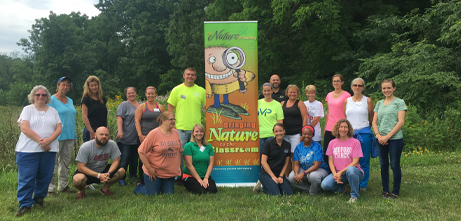 The Nature of Teaching team includes:
The Nature of Teaching team includes:
- Deb Arseneau, HHS Educator, Newton County
- Jarred Brooke, extension wildlife specialist
- Jay Christiansen, health and human sciences extension educator for Vigo County
- Robert Cordes, Maine Department of Inland Fisheries and Wildlife (MDIFW) wildlife special projects coordinator
- Molly Hoag, health and human sciences extension educator for Wells County
- Molly Hunt, health and human sciences extension educator for Delaware County
- Rebecca Koetz, urban ag/home horticulture extension educator for Lake County
- Tami Mosier, 4-H youth development extension educator
- Kelsie Muller, health and human sciences extension educator for Benton County
- Dr. Rod Williams, professor of wildlife science
- Brad Zitscke, Maine Department of Inland Fisheries and Wildlife (MDIFW) assistant regional wildlife biologist
Nature of Teaching
Nature of Teaching YouTube Channel
Transporting Food Waste, The Education Store, Purdue Extension resource center
Resourceful Animal Relationships, The Education Store
Benefits of Connecting with Nature, The Education Store
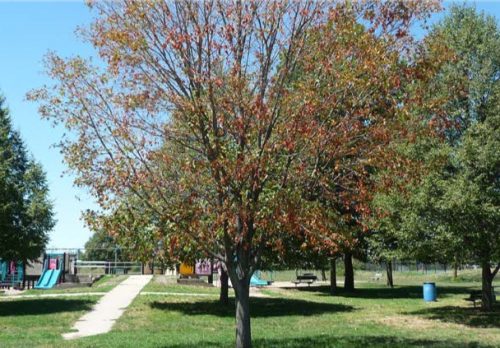 Many homeowners are finding their trees with dry and wilted leaves and no rain in sight. This publication describes how homeowners can deal with these drought-stressed trees, Drought? Don’t Forget the Trees!
Many homeowners are finding their trees with dry and wilted leaves and no rain in sight. This publication describes how homeowners can deal with these drought-stressed trees, Drought? Don’t Forget the Trees!
Drought can have a major impact on tree health and survival. Water is the most limiting ecological resource for a tree, and without adequate moisture, decline and death are imminent. It reduces carbohydrate production, significantly lowering energy reserves and production of defense chemicals in the tree.
Trees in a weakened state from drought are more susceptible to pests, which can further weaken the tree, and even kill part or all of it. Although there is nothing we can do to prevent drought, it is important to know what can be done to reduce long-term effects of prolonged dry conditions.
Resources:
Water Your Trees, Video, Purdue Extension – Forestry and Natural Resources (FNR) YouTube Channel
Trees in Times of Drought, Video, Purdue Agriculture
INPREPared, Purdue Extension
Drought Information, Indiana Department of Natural Resources
Tree Planting Part 1: Choosing a Tree video, Purdue Extension-FNR YouTube Channel
Lindsey Purcell, Chapter Executive Director
Indiana Arborist Association
Purdue Landscape Report: Hot, dry summers are not that unusual in the Midwest, but 2020’s hot dry spell started considerably earlier than usual, before summer even officially began! To make it a triple whammy, the hard freeze in early May caused some landscape plants to burn up more stored carbohydrate reserves to produce a second round of foliage.

(Figure 1) US Drought Monitor
I’m sure I don’t have to point out that most of Indiana is currently experiencing abnormally hot, dry conditions. Although recent rains have brought relief to some areas, any respite is sure to be temporary. Seasonal thunderstorms may deluge some landscapes with water while other areas, even those close by, may stay fairly dry. Much of the area has experienced highs in the upper 80’s to over 90º F over the past month.
Leaf scorch on trees and shrubs, appearing as a browning along the edges of the leaves, is very common in dry summers. While minor cases of leaf scorch are not very harmful, prolonged lack of moisture can spell disaster for landscape plants.
Young and newly established plants are most susceptible to the dry conditions, but even established plants may reach a critical point during prolonged drought. If the heat and drought continue this summer, branch dieback, combined with eventual root death, will make plants more susceptible to winter injury. Plants that were already under stress from other factors may succumb to severely dry soils.
The intense heat makes it difficult for plants to keep up with water and cooling requirements, even in areas where moisture is adequate. One of the ways that plants cool themselves is through transpiration, which allows water to evaporate from the foliage. Plant leaves have pores called stomata that can open and close to allow water vapor and gas exchange with the environment. During extreme heat and/or drought, stomata will nearly close, thus reducing transpiration and exchange of carbon dioxide and oxygen. The end result is seen as wilting foliage and leaf scorch. But not so obvious is that reduced water uptake and gas exchange also leads to reduced production of carbohydrates through photosynthesis and reduced uptake of soil nutrients, having longer term impact on plant health.
There is still plenty of summer yet to get through to see the further challenges ahead. Meanwhile, we can mitigate some of the stress by watering landscape plants as needed where feasible.
Resources
US Drought Monitor
Indiana – Purdue Rural Emergency Preparedness, Purdue Extension website
In Times of Drought, Indiana Yard and Garden, Purdue Consumer Horticulture
Drought? Don’t Forget the Trees, The Education Store, Purdue Extension resource center
Turfgrass Disease Profiles: Summer Patch, The Education Store
Iron Chlorosis of Trees and Shrubs, The Education Store
, Extension Consumer Horticulturist
Purdue University Department of Horticulture and Landscape Architecture
Purdue Forestry & Natural Resources extension specialists gathered for a Facebook LIVE event held May 5th to answer questions on a wide range of topics from woodland management to wildlife habitat, ponds to invasive species and more.
Topics ranged from what to do about moles, voles and Canada geese causing damage in your yard, to how to pick the right tree for your landscape and how to measure the worth of your trees. The presentation also included segments on what to do about algae in your pond to how to know if you need to restock it as well as what to do about invasive plant species and how to protect your trees from deer damage.
Get advice from extension specialists Jarred Brooke, Lenny Farlee, Brian MacGowan, Lindsey Purcell, Rod Williams and Mitch Zischke in the video below.
If you have any further questions feel free to send your questions by submitting our Ask An Expert form.
Resources mentioned:
Purdue Extension – The Education Store
Purdue Report Invasive Species Website
Midwest Invasive Species Network Database
TreesAreGood.org
Find a Forester in Indiana
Improve My Property for Wildlife, Purdue Extension
Online Mole Program, Event May 14th, Purdue FNR Extension
Have you seen a hairless squirrel, Got Nature? Blog, Purdue FNR Extension
Stocking Fish, The Education Store, Purdue Extension Resource Center
Tree Selection for the “Un-natural” Environment, The Education Store
Selecting a Nuisance Control Operator, The Education Store
Forest Products Price Report (pdf), Indiana Department of Natural Resources (IDNR)
Indiana DNR Nuisance Goose Control Options (pdf), Indiana Department of Natural Resources (IDNR)
Turtles of Indiana, The Education Store
Salamanders of Indiana, The Education Store
Frogs and Toads of Indiana, The Education Store
Snakes and Lizards of Indiana, The Education Store
Aquatic Plant Management, The Education Store
Native Grasses, The Education Store
Preventing Deer Browsing on Trees/Shrubs, Video, Purdue Extension Youtube Channel
Brian MacGowan, Wildlife Extension Specialist
Purdue University, Department of Forestry and Natural Resources
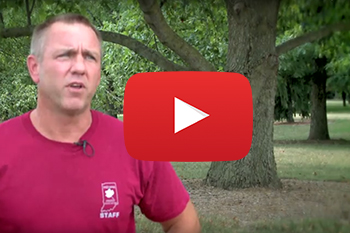 Water is the most limiting ecological resource for a tree, and without adequate moisture, decline and death are imminent. Drought can have a major impact on tree health and survival. It reduces carbohydrate production, significantly lowering energy reserves and production of defense chemicals in the tree.
Water is the most limiting ecological resource for a tree, and without adequate moisture, decline and death are imminent. Drought can have a major impact on tree health and survival. It reduces carbohydrate production, significantly lowering energy reserves and production of defense chemicals in the tree.
Trees in a weakened state from drought are more susceptible to pests, which can further weaken the tree, and even kill part or all of it. Although there is nothing we can do to prevent drought, it is important to know what can be done to reduce long-term effects of prolonged dry conditions.
Urban Forestry Specialist Lindsey Purcell describes how homeowners can deal with drought-stressed trees in the short-term and long-term in his publication “Drought? Don’t Forget the Trees!” Purcell also provides insight on the state of Indiana’s drought-stressed trees and how to protect them in the video “Trees in Times of Drought.”
Resources:
Trees in Times of Drought, Video, Purdue Agriculture
Drought Information, Indiana Department of Natural Resources
Drought? Don’t forget the trees!, The Education Store
Corn Belt Farmers’ Concerns About Drought and Heat-related Threats to Their Farm Operations, The Education Store
Safety Harvesting Quality Forage in a Drought, The Education Store
Planting Your Tree Part 1: Choosing Your Tree, Purdue Extension YouTube Channel
Tree Defect Identification, The Education Store
Tree Wound and Healing, Got Nature? Blog, Purdue Extension – Forestry and Natural Resources
Surface Root Syndrome, The Education Store
Planning the Tree Planting Operation, The Education Store
Tree Risk Management, The Education Store
ID That Tree, Purdue Extension-FNR YouTube playlist
Subscribe – Purdue Extension-FNR YouTube Channel
Lindsey Purcell, Chapter Executive Director
Indiana Arborist Association
Indiana has experienced extreme weather over the last couple of years. Extreme heat, draught, cold, winds, you name it, we’ve dealt with it. Most recently, through June and July, Indiana has experienced record-breaking rainfall and flooding. These weather conditions can make it difficult for our surroundings, but it can also cause a lot of stress on our trees.
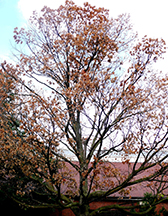
Photo credit: Keith Robinson
Urban trees are more susceptible to weather-related injury because of their oftentimes compromised root systems. In forested areas, trees spread their roots out two to three times the length of the tree. This is important because roots are the tree’s way to receive oxygen from the soil. This provides for a healthy defense system, giving the tree advantages like the ability to draw in moisture during dry spells and secrete fungi- and insect-repelling chemicals. In urban areas, roads and construction oftentimes sever roots or restrict where they can go, leaving the trees in a vulnerable state.
Our vulnerable urban trees are especially likely to be harmed by weather-induced stress. Symptoms like browning of leaves, dying branches and early coloration in the fall are all signs that a tree’s health is declining.
Keep an eye on your trees, and if you are concerned, use the Purdue Tree Doctor app or submit a sample to the Purdue Plant and Pest Diagnostic Lab as you seek best practices to care and protect your trees.
Resources
Purdue Experts: Tree Deaths Across Indiana May be Related to Weather Stress, Purdue Agriculture News
Drought? Don’t forget the trees! The Education Store, Purdue Resource Center
Plan Today For Tomorrow’s Flood, The Education Store
Community & Urban Forestry, Indiana Department of Natural Resources
The Root of the Problem, Northern Woodlands
Purdue University Agriculture News
Lindsey Purcell, Urban Forestry Specialist
Department of Natural Resources, Purdue University
B. Rosie Lerner, Extension Consumer Horticulture Architecture
Department of Horticulture and Landscape Architecture, Purdue University
Recent Posts
- Drought Spreading Throughout Much of the Midwest-Purdue Landscape Report
Posted: September 29, 2023 in Alert, Drought, How To, Plants, Wildlife - Early Fall Color – A Symptom of Stress, Purdue Landscape Report
Posted: September 20, 2023 in Alert, Disease, Drought, Forestry, Forests and Street Trees, Plants, Urban Forestry, Wildlife - Warm, wet spring predicted for Indiana
Posted: March 17, 2023 in Drought, Forestry, Forests and Street Trees, Gardening, Plants, Urban Forestry, Woodlands - What is happening to the Weeping Willows?
Posted: July 19, 2022 in Drought, Forests and Street Trees, How To, Urban Forestry - Nature of Teaching Program Receives Environmental Education Award
Posted: October 30, 2020 in Aquaculture/Fish, Aquatic/Aquaculture Resources, Disease, Drought, Forestry, Forests and Street Trees, Gardening, Got Nature for Kids, How To, Invasive Animal Species, Invasive Insects, Land Use, Natural Resource Planning, Nature of Teaching, Plants, Ponds, Safety, Wildlife - Trees Stressed Due to Drought? Know the Signs and What to Do
Posted: September 21, 2020 in Disease, Drought, Forestry, Forests and Street Trees, Urban Forestry - Dog Days of Summer Barking Early This Year
Posted: July 13, 2020 in Disease, Drought, Forestry, Forests and Street Trees, Gardening, Plants, Urban Forestry - Facebook LIVE: Ask the Expert
Posted: May 14, 2020 in Aquaculture/Fish, Aquatic/Aquaculture Resources, Disease, Drought, Forestry, Forests and Street Trees, Gardening, How To, Invasive Animal Species, Invasive Insects, Land Use, Natural Resource Planning, Plants, Ponds, Publication, Timber Marketing, Urban Forestry - Be Sure to Check Out the Extension Pub “Drought? Don’t Forget the Trees!”
Posted: September 4, 2015 in Drought, Forestry - Keep an Eye on Urban Trees Dying From Weather Stress
Posted: August 20, 2015 in Drought, Forestry, Urban Forestry
Archives
Categories
- Alert
- Aquaculture/Fish
- Aquatic/Aquaculture Resources
- Ask the Expert
- Christmas Trees
- Community Development
- Disease
- Drought
- Forestry
- Forests and Street Trees
- Gardening
- Got Nature for Kids
- Great Lakes
- How To
- Invasive Animal Species
- Invasive Insects
- Invasive Plant Species
- Land Use
- Natural Resource Planning
- Nature of Teaching
- Plants
- Podcasts
- Ponds
- Publication
- Safety
- Spiders
- Timber Marketing
- Uncategorized
- Urban Forestry
- Webinar
- Wildlife
- Wood Products/Manufacturing
- Woodland Management Moment
- Woodlands
